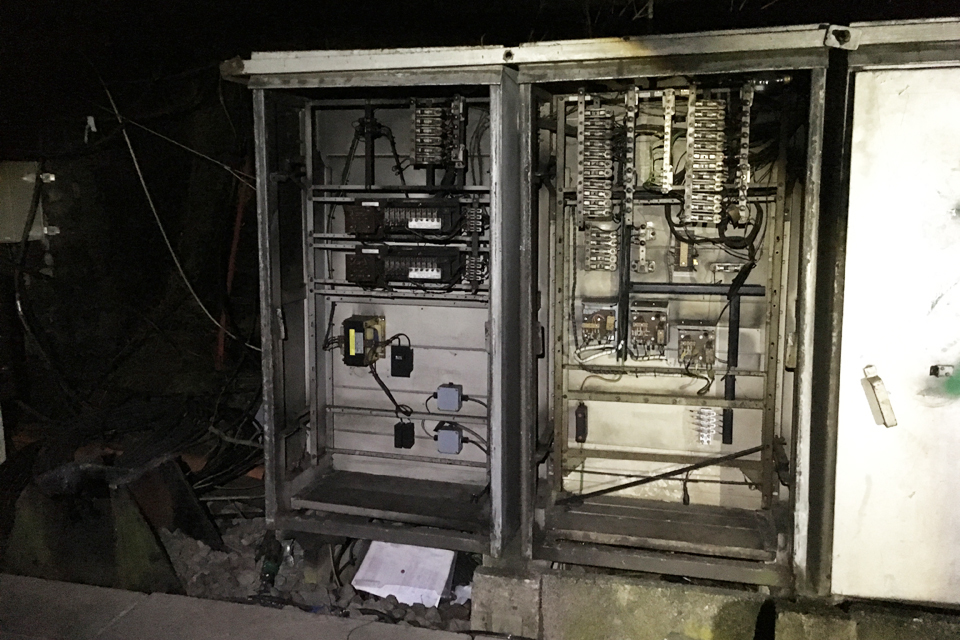Trains struck a location cabinet door in Chipping Sodbury Tunnel, 20 February 2017
Published 18 May 2017
1. Important safety messages
This accident demonstrates the importance of:
- track workers and managers being suitably briefed that the air flows generated by trains within tunnels can be significant, and capable of forcing open unsecured lineside cabinet doors which may then strike passing trains
- complying with the rules for securing doors of location cabinets when work has been completed, and checking them before confirming that lines are safe and clear for the passage of trains
- introducing control measures during the planning of works to reduce the risks associated with unsecured location cabinet doors during or after decommissioning of the cabinets
- being aware of NIR 3350/218 and the need to check that the Train Protection Warning System (TPWS) equipment is working normally in the event of the train sustaining damage in a collision with an object or debris on the track
2. Summary of the accident
At 17:12 hrs on Monday 20 February 2017, the driver of freight train 6B50, the 15:45 hrs service from Swindon to Llanwern, operated by DB Cargo, struck an object on the down line close to the eastern end of Chipping Sodbury Tunnel. This caused the air brake pipes between the locomotive and the first wagon to part. Once the train had stopped the driver examined his train and reconnected the pipes before proceeding.
At 17:24 hrs the driver of Great Western Railway passenger service 1L76, the 15:29 hrs service from Swansea to London Paddington, reported striking a ‘metallic’ object in the same area on the up line. This caused a loss of power to the buffet car. The train proceeded to Swindon, where staff found two broken outer window panes. The service continued to Reading where it was terminated.
After train 1L76 had returned empty to Landore depot near Swansea, fitters found that there was damage to the TPWS aerial that had been at the leading end through Chipping Sodbury tunnel, rendering the system ineffective. However, during its previous journey, between Swindon and Reading, the Automatic Train Protection system was working correctly and therefore had the train passed a signal at danger, the brakes would still have applied automatically.
It is a feature of the TPWS system fitted to this train that its self-test facility is only enabled during the power-up test, ie when switching on a cab desk. It does not have the ability to detect damage to an aerial which renders the system inoperative during normal running, unlike more modern versions of the system which do have this ability. Following the accident, Great Western Railway issued an alert (NIR 3350/218) to brief its drivers to conduct a TPWS power-up test following any strike with an object which causes physical damage to the train.
3. Cause of the accident
This accident occurred because the doors of two location cabinets near the eastern end of Chipping Sodbury Tunnel had not been secured following signalling work carried out during a possession the previous weekend, the 18 and 19 February 2017.
The type of location cabinet involved has a single piece door which is fully removable (ie it has no hinges). The doors, which weigh around 10 kg each, are made from wood faced with an outer aluminium skin.

Two grey location cabinets showing signal wiring with the doors missing. A third cabinet still has its door (image courtesy of Network Rail)
To close the cabinet, the door has to be replaced upwards into a lip along its upper edge and two handles turned to drive locking tongues into the side catches of the cabinet. The design of the doors is such that the handles need to be padlocked to stop them falling to the open position as a result of vibration and aerodynamic forces from passing trains.
The work during the weekend of 18 and 19 February was being undertaken by Alstom Transport UK Limited. One of the tasks was the removal of redundant location cupboards including six cupboards close to the eastern end of Chipping Sodbury tunnel. This required the cupboard doors to be unlocked.
There were delays to the work due to problems with the availability of plant, leading to insufficient time to remove these cabinets. Although staff have stated that the doors were closed when they finished work, an inspection following the accident found one door leaning against the back of the location cabinets. The remains of the other door (the one struck by the trains) were found just outside the tunnel. A padlock was found on top of one of the cupboards.
Although some hazards and associated control measures were stated in the work package plan and task briefing documents, the specific task of ensuring that cabinet doors were secured before handing the lines back to traffic had not been identified.
4. Previous similar accidents
RAIB report 12/2015 describes a collision between a train and a location cabinet door in Watford Tunnel. In that accident the cabinet had hinged doors and the investigation found that the doors which had probably been closed but not securely locked, had been forced open by aerodynamic forces from passing trains.
Recommendation 2 of the report intended that Network Rail should make explicit the processes for handing back a work site to reduce the risk arising from the railway ‘not being safe and clear for the passage of trains.’
You can print this safety digest

